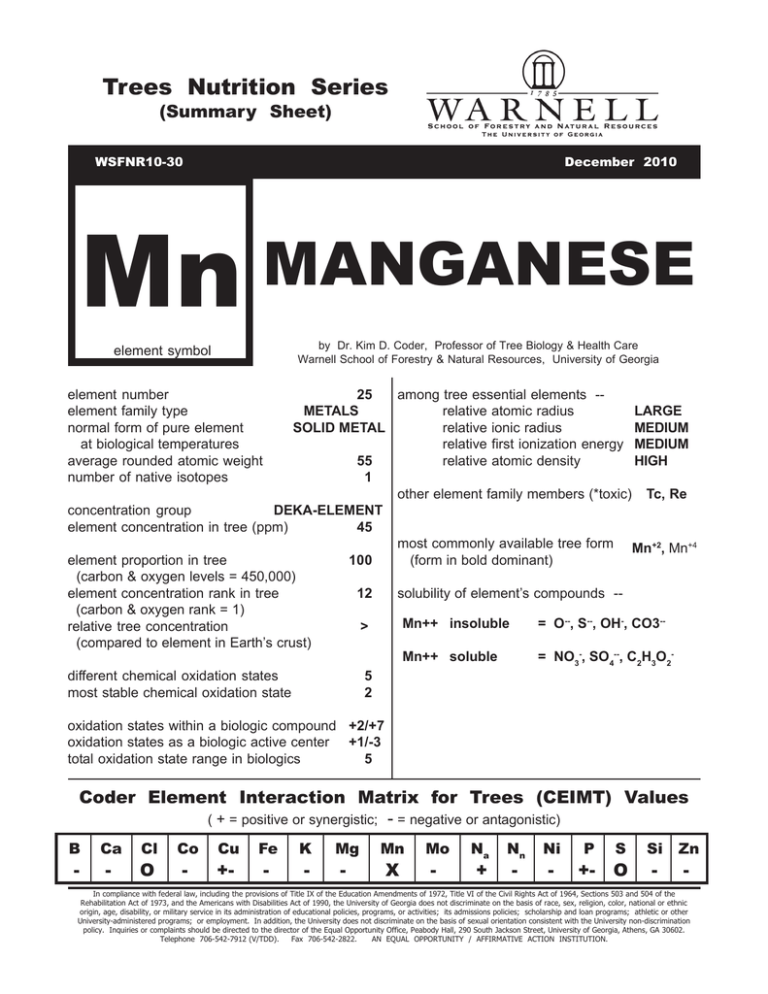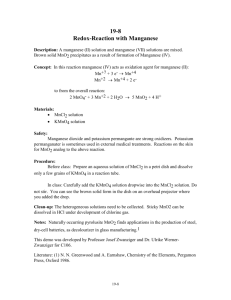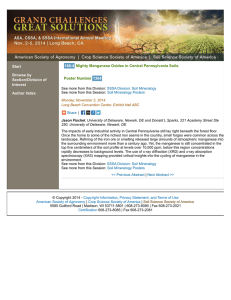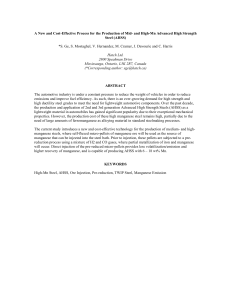Mn MANGANESE Trees Nutrition Series (Summary Sheet)
advertisement

Trees Nutrition Series (Summary Sheet) WSFNR10-30 December 2010 Mn MANGANESE by Dr. Kim D. Coder, Professor of Tree Biology & Health Care Warnell School of Forestry & Natural Resources, University of Georgia element symbol among tree essential elements -25 relative atomic radius METALS LARGE relative ionic radius SOLID METAL MEDIUM relative first ionization energy MEDIUM relative atomic density 55 HIGH 1 other element family members (*toxic) Tc, Re concentration group DEKA-ELEMENT element concentration in tree (ppm) 45 most commonly available tree form Mn+2, Mn+4 (form in bold dominant) element proportion in tree 100 (carbon & oxygen levels = 450,000) solubility of element’s compounds -element concentration rank in tree 12 (carbon & oxygen rank = 1) Mn++ insoluble = O--, S--, OH-, CO3-relative tree concentration > (compared to element in Earth’s crust) Mn++ soluble = NO3-, SO4--, C2H3O2different chemical oxidation states 5 most stable chemical oxidation state 2 element number element family type normal form of pure element at biological temperatures average rounded atomic weight number of native isotopes oxidation states within a biologic compound +2/+7 oxidation states as a biologic active center +1/-3 total oxidation state range in biologics 5 Coder Element Interaction Matrix for Trees (CEIMT) Values ( + = positive or synergistic; - = negative or antagonistic) B - Ca - Cl O Co - Cu +- Fe - K - Mg - Mn X Mo - Na + Nn - Ni - P +- S O Si - Zn - In compliance with federal law, including the provisions of Title IX of the Education Amendments of 1972, Title VI of the Civil Rights Act of 1964, Sections 503 and 504 of the Rehabilitation Act of 1973, and the Americans with Disabilities Act of 1990, the University of Georgia does not discriminate on the basis of race, sex, religion, color, national or ethnic origin, age, disability, or military service in its administration of educational policies, programs, or activities; its admissions policies; scholarship and loan programs; athletic or other University-administered programs; or employment. In addition, the University does not discriminate on the basis of sexual orientation consistent with the University non-discrimination policy. Inquiries or complaints should be directed to the director of the Equal Opportunity Office, Peabody Hall, 290 South Jackson Street, University of Georgia, Athens, GA 30602. Telephone 706-542-7912 (V/TDD). Fax 706-542-2822. AN EQUAL OPPORTUNITY / AFFIRMATIVE ACTION INSTITUTION. Manganese (Mn) is a hard, whitish-gray, metal not found in its pure form in nature. It can exist as seven isotopes, one stable, five short-lived and one long-lived (~3.7 million years). It was discovered in 1774 and was named from the Latin word for “magnet.” Manganese is similar to iron in it will rust. It is used in steel making, as a glass colorant, and in batteries. Manganese is taken up in a tree as the ion Mn++. Other manganese ions in a soil are converted to Mn++ for uptake. Figure 1. Manganese is a metal used in small amounts but essential to a number of key processes in trees. Manganese serves as the center block upon which water is split at the start of photosynthesis (LHCII) and oxygen is given off. Manganese helps facilitate photosynthesis. Manganese is also part of a scavenger enzyme which removes damaging oxygen radicals inside cells. Manganese activates several other enzymes. Manganese stimulates and supports amino acid and lignin synthesis. Pest resistance in trees is facilitated by manganese by increasing lignification, generating more defensive compounds, and chemically inhibiting several fungal enzymes. In some uses in a tree, manganese and magnesium are interchangeable in limited amounts. Manganese is an essential elements tied in many ways to oxygen management in a tree. Manganese is immobile in a tree and any deficiency will show on new tissues. Deficiency is usually seen on fully expanded new leaves, not on forming leaves. Manganese is commonly deficient in soil pH from 7.3 - 8.5, as well as soils with free CaCO3. Generally as pH increases manganese availability declines sharply. Figure 2. Organic soils and soils with high concentration of composted organic matter tend to tie up manganese. Manganese deficiency commonly generates uneven mottled yellowing and bleaching between leaf veins mimicking iron deficiency (iron deficiency presents more evenly through out tissues). Leaves and new shoots will show dead patches, marginal and tip bleaching, and discolored streaks. Leaf veins may become darker as blades become more yellow in color. Manganese may also present with stunted tissues. In trees manganese deficiency symptoms usually occur in the outside of the middle crown areas while magnesium deficiency usually are seen at the crown top in new tissues. The time between yellowing and bleaching of leaf tissues and death is usually short. Manganese deficiency is mistaken and misdiagnosed for magnesium, iron, or sulfur deficiencies. Manganese toxicity occurs in anaerobic and acid soils (along with cobalt and nickel). Under these conditions of manganese toxicity, bark lesions and leaf deformation and speckling will can occur. More and more manganese is taken up as pH falls (becomes more acidic). Tree Symptom Summary Manganese performs two dominant roles in trees: 1) Parts of enzymes like the water splitting enzyme in light harvesting center two (LHCII) and in the superoxide dismutase enzyme; and, 2) Activator / modifier of many enzymes like in the citric acid cycle. Deficiency symptoms can quickly occur physiologically downstream from these points. When deficient, manganese has been cited as generating the following symptoms: 2 tree part primary symptom element deficiency responsible roots stunted / damaged Mn -- also B, Cl, Cu, N, Ni, P, K, S, Si, Zn increase pest effectiveness Mn -- also Ca, K, Mg, Si shoots stunted / damaged / killed leaves color -- dark viens color – general chlorosis Mn -- also Cu, P, Zn Mn -- also B, Cl, Cu, Fe, K, Mg, Mo, Ni, S, Zn intervienal chlorosis / death Mn -- also Fe, Mg, Mo, Ni, S, Zn stunted / distorted blades Mn -- also B, Cl, Cu, K, Mg, Mo, N, Ni, Zn whole tree increase pest effectiveness Mn -- also B, Cl, K, Mg, Ni, Si Mn -- also B, Ca, Cl, Cu, Fe, Mo, N, Ni, P, K, S, Zn Manganese is considered an intermediate among elements for mobility within a tree (immobile rank 7th). symptom tissue location & age element mobility inside tree causal elemental deficiency new tissues dominant immobile Mn -- also B, Ca, Co, Cu, Fe, Ni, S, Zn intermediate mobile/immobile Mn -- also Mo, S, Zn At pH 7.3 to 10.0, manganese is poorly available or unavailable to trees. When toxic, manganese has been cited as generating the following symptoms: tree part primary symptom toxicity responsible roots root browning / death Mn -- also Fe, Ni shoots secondary meristems periderm lesions Mn -- also Ni leaves color -- chlorosis curling / cupping / distorted marginal burn / scorch brown lesions Mn -- also B, Ca, Cl, Co, Cu, Ni Mn -- also Cl, Mo, Ni Mn -- also B, Cl, Ni Mn -- also Fe Manganese shares both toxic and deficiency symptoms with many other essential elements in trees. Proper identification of the cause for toxicity or deficiency symptoms must, at the least, involve tissue analysis for deficiencies and soil testing for toxicities. 3 123456789012345678901234567 123456789012345678901234567 123456789012345678901234567 123456789012345678901234567 123456789012345678901234567 123456789012345678901234567 123456789012345678901234567 123456789012345678901234567 123456789012345678901234567 123456789012345678901234567 123456789012345678901234567 123456789012345678901234567 123456789012345678901234567 123456789012345678901234567 123456789012345678901234567 123456789012345678901234567 123456789012345678901234567 123456789012345678901234567 123456789012345678901234567 123456789012345678901234567 123456789012345678901234567 123456789012345678901234567 123456789012345678901234567 123456789012345678901234567 123456789012345678901234567 123456789012345678901234567 123456789012345678901234567 123456789012345678901234567 123456789012345678901234567 123456789012345678901234567 123456789012345678901234567 123456789012345678901234567 tree uptake Mn Mn +++ (Mn2O3) ++ Mn ++++ (MnO2) Figure 1: Conversions of manganese (Mn) in a healthy soil. Mn++ is the ion form in soil solution and on soil exchange sites available to trees. Dr. Kim D. Coder, 2010 4 relative available Mn (percent) 100 75 50 25 0 5 6 7 soil pH 8 Figure 2: Estimated relative manganese (Mn) available in soil associatd with soil pH. Dr. Kim D. Coder, 2010 5




